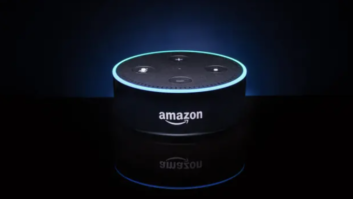It’s not unusual these days for groups to acquire more stations than they had planned earlier. This requires squeezing studios into smaller and smaller spaces.
Mounting a rack turret up against a wall may work in the short term, but the arrangement will be a royal pain when you need to get behind the equipment for service or maintenance.
Cumulus Market Engineer Tom Holmes found a simple solution at his local big-box store, a 4-inch lazy susan tray. When the tray is screwed to the console countertop and the rack is placed on the rotating turntable, the access problem is solved. For just a few dollars, your rack now can spin around, as shown in Fig. 1.


Fig. 1: Put a lazy susan under your equipment rack to ease access in tight quarters, as demonstrated here.
Be sure to provide adequate wiring service loop so wires aren’t snagged or pulled when the rack cabinet is turned.

Fig. 2: Secure the rack with a barrel bolt lock. To hold the rack in place and to prevent it from spinning during on-air operation, Tom added a simple barrel bolt lock, such as that shown in Fig. 2. (Google “barrel bolt lock” for a selection of types.) The one Tom used is spring-loaded, which made fastening easier. A small hole drilled in the console tabletop nestles the barrel bolt and keeps the rack secure.
Thanks, Tom, for a way to squeeze more space out of our studios and to provide easy access at the same time.
Consulting engineer R. Morgan Burrow, P.E., notes that the FCC recently adopted rules reducing the distance to which AM stations are protected by new tower construction.
“The new rules effectively make the protected distance to a non-directional station one wavelength, and to a directional station 10 wavelengths, and specify the Method of Moments for determining the extent of re-radiation. Measurements are still accepted, but the onus is now on the AM station. This replaces the 0.5 mile ND/2 mile DA rule,” he says.
“The problem is that the NDA protection distance, in particular, is insufficient. Look in the old Carl Smith pattern books, and there are patterns for one wavelength separation. At 1600 kHz, one wavelength is 615 feet … which is way too close. Look on the groundwave attenuation curves, and the curves are compressed at the upper left, and are essentially a straight line out to at least 1 km (0.621 mile).”
Burrow has been advising clients with directional or nondirectional AMs to contact the zoning board(s) for the city of license and the transmitter site. Your letters to the zoning boards should request denial of any new tower construction or significant modifications of any existing structures, until the tower proponent has coordinated with the affected AM station(s). Some cellular operators may complain, but the local zoning boards will do the job the FCC is abdicating.
Burrow adds that the AM stations pay local property taxes, so the zoning board should help protect taxpayer interests. The two-mile (DA) and 0.5 mile (NDA) former rule worked well for years.
Morgan closes with an interesting question, “Do you believe CBS would tolerate a cell tower built within 813 feet of their 50 kW ND station WCAU in Philadelphia?”
His comments add another reason that engineers should be diligent in reviewing local zoning applications and inspecting their AM sites so new tower construction can be spotted.
Here’s a neat software application provided by frequent contributor and Malaysian broadcast engineer Paul Sagi.
It’s a free application called PolarPlot. Simply put, it’s a program for plotting a polar diagram of an antenna. Users have the choice of viewing the polar plot in either a circular or rectangular grid. The scale can be linear or log.

Fig. 3: A screenshot from the PolarPlot program.
Designed for radio amateurs, this program lets you compare and evaluate antenna patterns. Front-to-back ratio can be plotted as well as the antenna side lobes. And the software is free.
You can download the software and get information at http://polarplot.software.informer.com/.
Reading Workbench is like taking a college course in hands-on radio problem-solving. Contribute your ideas, help your fellow engineers and qualify for SBE recertification credit. Send tips to [email protected]. Fax to (603) 472-4944.
John Bisset has spent 44 years in the broadcasting industry He handles West Coast sales for the Telos Alliance. He is SBE certified and is a past recipient of the SBE’s Educator of the Year Award.












